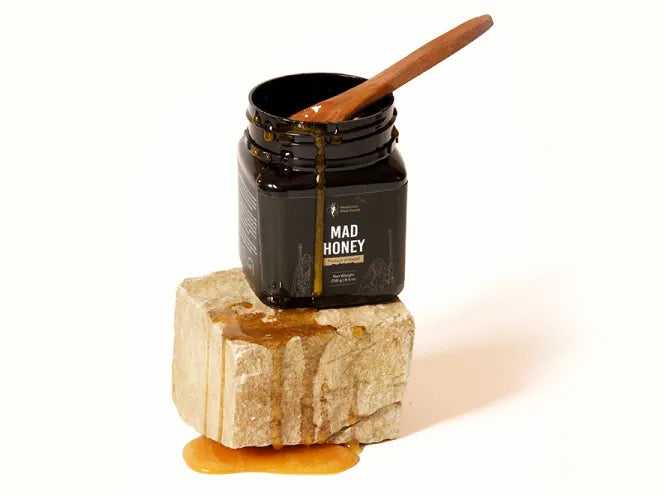The brave, mad honey hunters make it seem easy and doable for the normal human being. But unfortunately, this is not the case! Harvesting honey from high cliffs is a challenging and delicate job that only the skilled and Experienced Gurung honey hunters seem to be cracking. Considering the delicacy of the harvest and outcome they get afterwards. a fancy term was coined which is called Mad Honey Hunting.
What is Mad Honey Hunting?
Mad Honey or commonly known as Cliff Honey is harvested from high cliffs of Nepal. The entire process of harvesting wild bee colonies or commonly known as the Himalayan Giant Bees or scientifically Apis Laboriosa by the traditional means and tools is known as Mad Honey Hunting.

The Origin of Mad Honey Harvesting (Hunting)
You can trace the use of Mad Honey back hundreds, if not thousands, of years. Many Historical records show that several cultures have a long history of using this natural sweetener dating as far back as ancient Greece. Alternatively, Nepal and Turkey do share origins of Mad Honey along with historical accounts of Xenophon. But the origin of Mad Honey Hunting has not been stated on the historical accounts.
One ancient history of Mad Honey was recorded where an elder of Honey Hunting community from Nepal stated that the process started around 22 generations earlier than him. The started the first honey hunting in Nepal and later the process was adopted to other places. The district is Lamjung and the location is somewhere between the remote cliffs. This is the reason why Lamjung is called as the Capital of Mad Honey Hunting. For thousands of years, the Gurung have been consuming this mystic nectar for their vital health. According to them it was used as a potent mood booster that would calm them and also give them a boost of energy.
Another such instance is in Northeast spain where a cave painting found within the foothills of Iberian System Mountain Range depicts prehistoric humans gathering honey climbing a ladder to reach colony of the bees. During those ancient civilizations, Hallucinogenic Honey served various purposes including medicinal, religious and even recreational uses.

The Gurungs: Daredevil Honey Hunters
The Gurung reside in the Lamjung district of Nepal. Originally, they came from Tibet and resided, they were brave and were known as the lionhearted tribe in Nepal. Most of them are farmers and rely on growing vegetables and rice. They live like recluses with little to no contact with the outside world.
Since agriculture was not enough to keep the community of Gurungs well fed, one daredevil took the courage to lead the team and scale the cliff to harvest the golden elixir from high cliff. The community was soon involved and they performed the tedious task because they could sell it at good price. The early harvesters did it, so their family and community members could be well fed which later became culture of Gurung Community and was adopted by new generations. Previously it was coined as the "Bhir maha" by the gurungs AKA Cliff Honey, now it's famous around the world as Mad Honey, Hallucinogenic Honey and more.
These Gurungs are not known by the people around the word until now, but the times have changed. Due to Mad Honey’s high-profile fame, they are getting the long-due recognition they deserve. Now world is slowly realizing the potential that this special nectar holds. With the power of social Media, Influencers and digital promotion they are getting the reputation as the crazy honey hunters of the Himalayas.
Gurung communities is the teaching ground of the real heroes when it comes to preserving and passing down the skills to the young generations. They have a profound connection with the Himalayas and familiarity with the landscapes where the rhododendron flowers grow. Hence, you can witness glimpses of honor and pride in their practices. These communities provide valuable insights into the sustainable harvesting of bee nectar and the importance of balancing cultural traditions with conservation efforts.
Mad Honey Hunting Season
The honey hunting is done in few parts around the world especially in Nepal. Nepalese mad honey harvesting season holds great significance for the Gurung community and is filled with both excitement and caution. This period typically unfolds during Nepal’s spring and autumn months when the massive Himalayan Giant honeybees swarm the cliffs and rocky crevices in the Himalayan foothills.
Timing is crucial because it aligns with the season when these bees gather nectar from rhododendron flowers which infuses the bee syrup with its unique psychoactive qualities. Throughout this season, Gurung honey hunters pay meticulous attention to nature’s cues and the bees’ behavior. The timing of the harvest is kept secret among bee nectar hunting groups, drawing upon generations of wisdom and experience to pinpoint the ideal moment.
Anticipation and enthusiasm mount as they gear up for their expedition, recognizing that the wild bees made, Hallucinogenic liquid gold they collect will not only provide sustenance but also hold a vital place in their cultural traditions.

Steps of Mad Honey Hunting
The Gurung take great risks to collect the golden sweetener. They hunt with no protective gear and mere flimsy hunting gear. The steps involved in collecting Mad Honey are as follows:
- Preparing Equipment : Harvesters prepare the necessary equipment before they set out on their hunt. The equipment includes long bamboo or wooden ladders, ropes and baskets. Also, to calm the brutal giant honeybees, they take smoking materials like dried wood and leaves.
- Finding a Hive : Honeybee hives can be found in various locations including cliff faces, tree hollows and rocky outcrops. The honey hunters check these areas carefully for signs of hive entrances such as bees coming and going and the presence of beeswax and honeycomb.
- Pre Hunt Rituals: Once the honey hunting process is about to be carried out they worship the nature, the bees and their local god. Even they sacrifice an animal to prevent any incidents from happening.
- Use Smokers : Giant honeybees are highly defensive of their nests. When they perceive a threat to their hive, they respond aggressively to protect it. Giant honeybees swarm in large numbers to defend their nest. This means that if the honey hunters disturb a hive, they will face hundreds or even thousands of angry bees. When they feel threatened, they will not hesitate to sting intruders repeatedly. For some honey hunters, these stings can cause severe allergic reactions. Hence, they smoke the dried leaves to distract the honey bees while they fulfil their quest for bee nectar. They approach the hive slowly and quietly to avoid agitating the bees.
- Harvest the Honey: With caution, they cut out sections of the honeycomb using a scraper or knife. They handle the cutting gently to avoid damaging the bees or the hive. Be gentle to avoid damaging the bees or the hive. Honey-hunting is teamwork! Once the smoke blankets the cliff, diverting the attention of the honeybees, one hunter gently tips the nest using a bamboo stick. Simultaneously, another hunter stands ready with a lowered wooden basket, poised to collect the precious Himalayan red honey as it slowly drips from the exposed honeycomb.
Also Read: Traditional Mad Honey Harvesting equipment
Hope For The Future
There remains a topic of debate within the honey hunting community, as some psychedelic honey hunters aspire for their children or grandchildren to receive an education.
In contrast, others are staunch advocates of honey hunting, fearing the influence of Westernization on their offspring.
Regrettably, young Gurungs often miss out on higher education opportunities due to their poor economic circumstances. Even though they receive primary education, the schools are far away and poorly organized.
Consequently, these young individuals lack the motivation to pursue a career in honey hunting, believing it may not offer them substantial prospects. This lack of interest is understandable. Mad honey, despite its unique qualities, has not received the recognition it deserves.
The potential of mad honey remains largely unexplored and underappreciated, leaving it disconnected from the culture it stems from. Unfortunately, many are unaware of the significance of mad honey and the economic opportunities it could generate.
However, there are whispers circulating about honey hunting and honey hunters, indicating a gradual shift in awareness.
Although numerous tourists visit honey hunting areas for sightseeing and honey hunting tours, the timing of their visits during unfavorable seasons often disrupts honey harvesting activities.
In the current scenario, a considerable number of Nepalese youths are compelled to seek employment abroad due to limited opportunities at home and young Gurungs appear to be following this trend.
It is undeniable that these young individuals often earn meagre incomes abroad, lacking significant skills and higher education and leaving behind their cultural treasure of real mad honey.
FAQs
Does harvesting Mad Honey hurt Giant Bees?
No, harvesting of Mad Honey does not hurt Giant Bees. The beekeepers are always aware about the potential damages to the bees. The Mad Honey harvesting community of the Gurungs have clear knowledge about the importance of these wild bees. They have been harvesting keeping a portion for the survival of the bees. They harvest only the outer layer of the honey comb where honey is stored, leaving behind the brood of the bees untouched.
Also, there is a unique behavior of the Himalayan Giant Bees where they usually leave the hive and relocate at warm temperatures when climate is cold. Also, they again move to the higher altitudes when temperature is hot. During migration they don't move at exact same hives which are left a while ago, as they don't prefer hives damaged by rain, wind and gravity. But the bees are seen to choose and inhibit previous hives from where Honey is harvested.
The honey hunting community who has been harvesting Mad Honey since years knows this and they know harvesting is essential for the bees and ecosystem. They know the Spring and Autumn are prime seasons where bees are active the most and hives are full of honey. So these two seasons are best for honey hunting on which you can get in contact with some tourism companies and join the expedition of Mad Honey Hunting.
Is harvesting honey good for the bees?
The sustainable harvesting of honey bee is quite good for the bees. The bees leave the hive whenever it feels overcrowded when they store excess honey and may lead to swarming. The dispersion of bees breaks unity among the bees and creates vulnerability among both the section of bees. Both the groups are vulnerable to the starvation, cold temperature, predator attack and diseases which can be major concern for the survival of the bees.
Is honey hunting legal in Nepal?
Yes, honey hunting is legal in Nepal as it has been practiced by Gurung Community since a long ago and is supported by the local government. The local government with close association to these hunters in the region has regulated law for the protection of the Wild Himalayan Bees. The hunters need to get local government approval for the hunt where the local government monitors harvesting, production and sale of the harvested honey.





